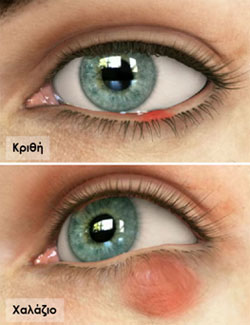The inflammation of the eyelids is called blepharitis and is the cause of unpleasant symptoms of irritation, lacrimation and redness.
The inflammation of the eyelids is called blepharitis and is the cause of unpleasant symptoms of irritation, lacrimation and redness.
There are two main forms: the staphylococcal and seborrheic blepharitis, which often overlap making it difficult to distinguish them.
The staphylococcal blepharitis is caused by infection by Staphylococcus aureus or epidermis. The palpebral rim is inflamed and often lashes are glued together with crust.
The seborrheic blepharitis is less intense due to the overproduction of sebum by the glands of the palpebral rim.
 Blepharitis may cause secondarily conjunctivitis, dry eye, punctate apoptosis of corneal epithelium, ulceration or scarring of the cornea (especially of lower cornea), eye barley, chalazion etc
Blepharitis may cause secondarily conjunctivitis, dry eye, punctate apoptosis of corneal epithelium, ulceration or scarring of the cornea (especially of lower cornea), eye barley, chalazion etc
The eye barley is an acute bacterial infection of the glands of the palpebral rim, getting a red painful swelling of the eyelid. Initially it is hard and pervasive, then it gets pus and forms a yellow top, whereas it is is automatically emptied and self-limited
The chalazion may affect either upper or lower eyelid and are due to clogging of the pores of the glands of the palpebral rim. Thus the resulting material is not discharged, resulting in accumulation and nodule formation. If conservative treatment, is not efficient, the chalazion may need surgical intervention by an ophthalmologist, performed with local anesthesia.
Treatment
The cornerstone of the treatment of inflammation of the eyelids is proper hygiene of eyelids.
The patient himself has to try to remove the pathological material and the crust of the eyelashes and eyelids, particularly of sebum plugs which clog the pores of the glands of the palpebral rim.
This can be accomplished following washing with lukewarm water and shampoo which does not sting the eyes, available in the market and using also special fluid tissues.
The use of artificial tear drops contributes to relief of symptoms, while local application of antibiotics in the form of an ophthalmic ointment for the control of microbes is also indicated.
 German
German Ελληνικά
Ελληνικά